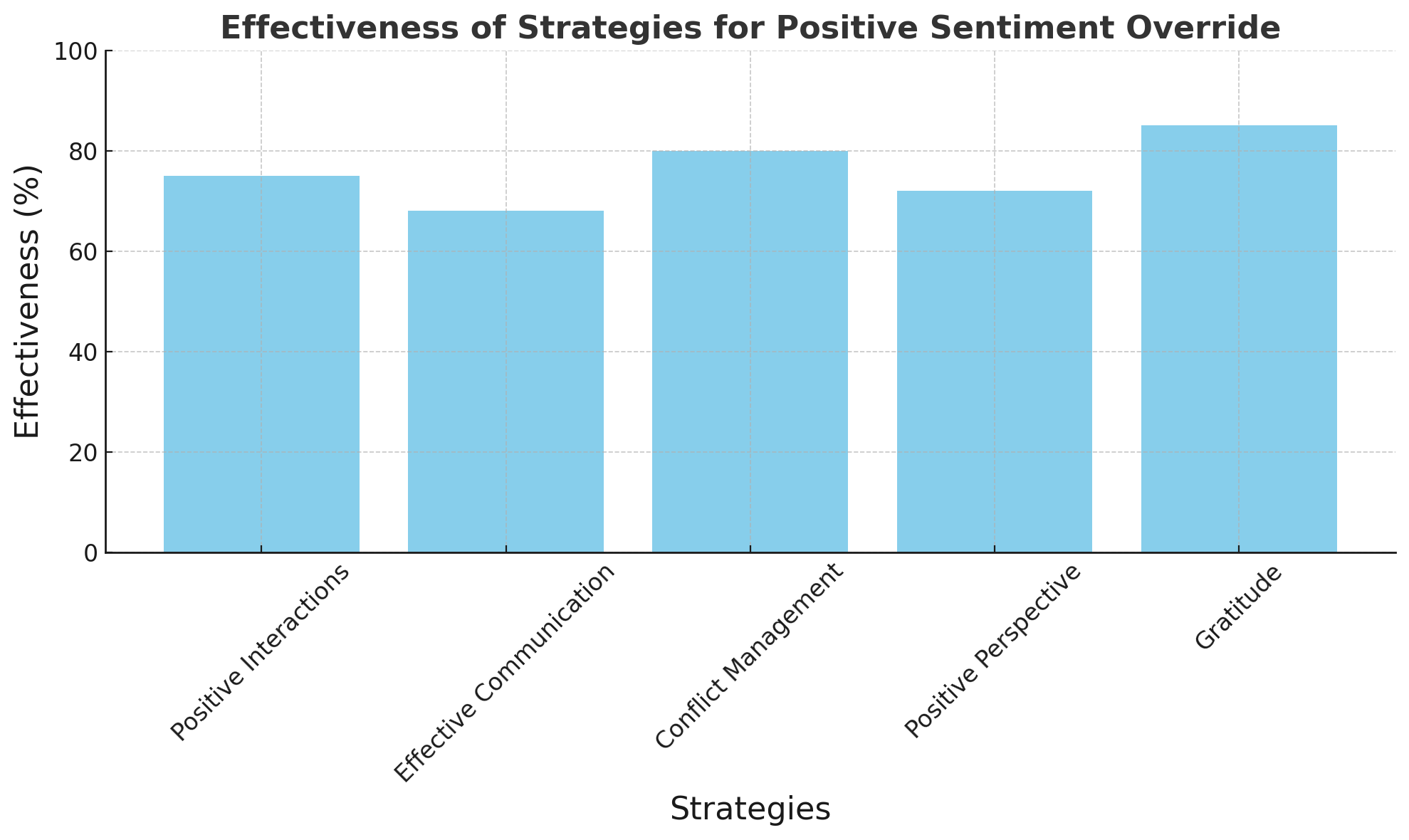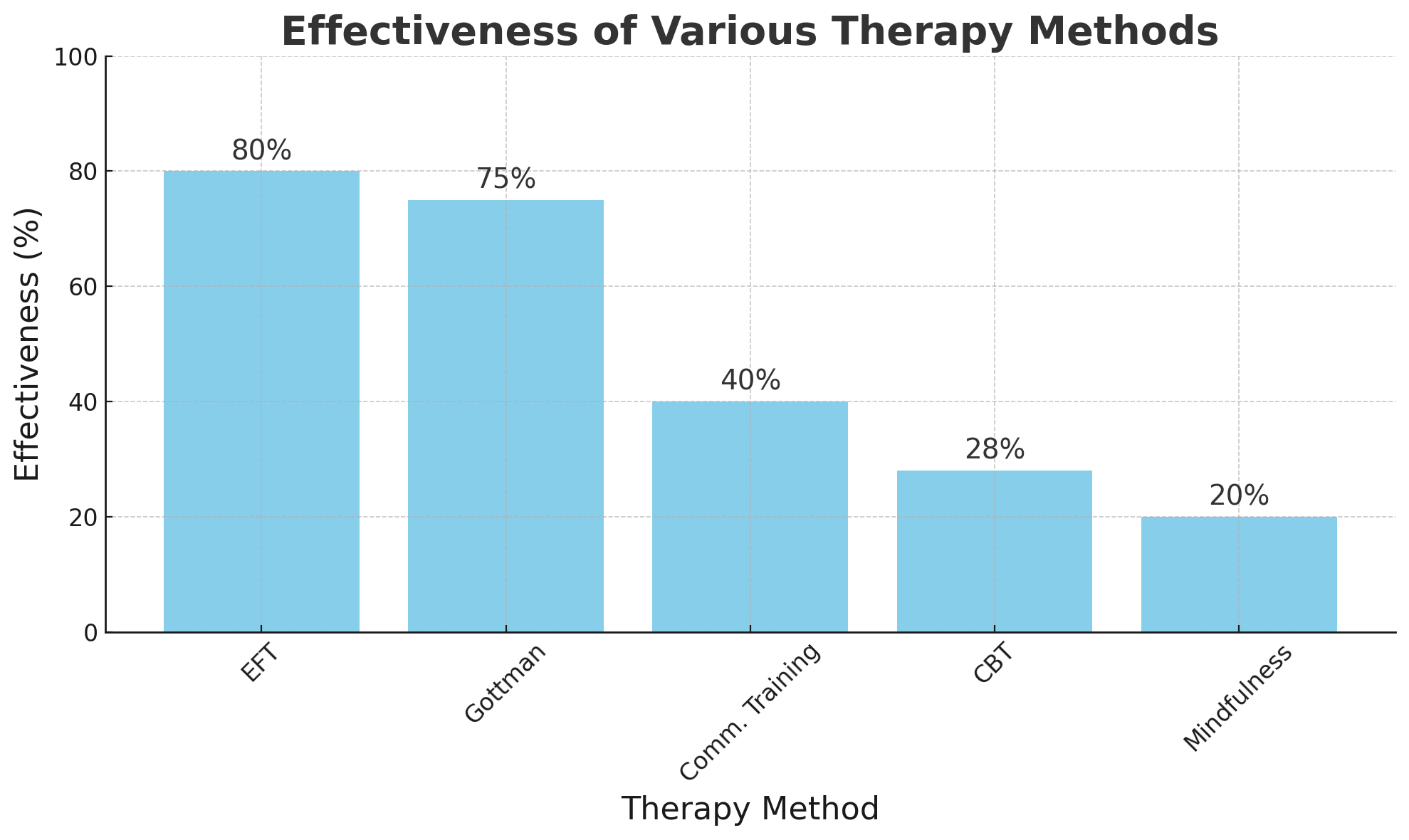Escape the Trap of Negative Sentiment Override: In-Depth Guide for Couples
Key Highlights:
- Negative sentiment override occurs when negative perceptions consistently overshadow positive ones in a relationship, leading to conflicts and dissatisfaction.
- To counter negative sentiment override, couples should focus on enhancing communication, recognizing positive interactions, and building emotional connections.
- Systematic tools like relationship assessments can help identify the extent of negative sentiment override and guide interventions to improve relational dynamics.
In the intricate dynamics of romantic relationships, negative sentiment override can undermine and rupture bonds between partners. A negative sentiment override occurs when negative perceptions or interactions consistently overshadow the positive ones, potentially leading to long-term dissatisfaction and conflict.
In this article, we introduce negative sentiment override and provide you with insights into its causes and signs. We also provide tips for practical self-help and therapy strategies that will help you turn toward your partner and enhance your relationship. Understanding and addressing negative sentiment override with the guidance of a mental health professionals, such as the counsellors and therapists at our therapy Calgary clinic can be crucial in nurturing a healthy relationship.
Table of Contents Show
Understanding John Gottman's Sentiment Override in Relationships
Negative sentiment override and positive sentiment override are psychological terms from John Gottman, a leading expert on relationships who created the 7 principles for making marriage work.
Negative sentiment override occurs when one or both partners in a relationship interpret neutral or even positive interactions negatively. This often leads to misunderstandings and escalating conflicts. On the other hand, positive sentiment override acts as a buffer during disagreements, allowing partners to maintain a positive view of each other and the situation, even during conflict, helping them to turn toward each other more readily.
Impact on Relationship Dynamics
What Causes Couples to Get Stuck in Negative Sentiment Override (NSO)?
Negative sentiment override can stem from several factors, each potent enough to trigger it independently if severe enough. However, it's more typical for a combination of factors to play a role. Here is a list of common factors that can contribute to negative sentiment override:
- Poor Communication: Misunderstandings often occur when partners communicate ineffectively. This lack of clarity can lead to feelings of resentment and frustration. For instance, if one partner frequently interrupts the other, this can create a sense of not being heard or valued, which fosters negative sentiment.
- Recurring Conflicts: When disputes remain unresolved, they can lead to a cyclical pattern where past frustrations color the perception of current interactions. Each partner may begin to expect negative outcomes from discussions, further entrenching the sense of conflict and misunderstanding.
- Negative Perspective: This is the heart of negative sentiment override. It involves a persistent negative view where even neutral or positive actions by one’s partner are perceived in a negative light. This could be something as simple as misinterpreting a compliment as sarcasm, leading to more significant relationship distress.
- Old Wounds: Old, unresolved issues can significantly contribute to negative sentiment override. These unresolved issues act like a filter through which current interactions are seen, making it hard for partners to move past them and appreciate positive present actions.
- Self-awareness and Perspective: Often, a lack of self-awareness can magnify negative sentiment override. If one partner is not aware of their biases or doesn’t realize how past experiences influence their current perceptions, they're more likely to stay stuck in a negative viewpoint. Learning to be present and evaluate situations independently of past hurts can mitigate this effect.
Recognizing Signs of Negative Sentiment Override
Negative sentiment override can subtly enter a relationship and significantly affect everyday interactions. Recognizing the signs early can help couples take action to prevent escalating conflicts and break free from negative sentiment.
Here’s what to watch for:
- Constant Criticism: When even small actions are met with criticism, it may suggest negative sentiment override. For instance, simple tasks like how someone loads a dishwasher could provoke unnecessary criticism or correction, indicating a deeper discontent where neutral or even positive actions are perceived negatively.
- Defensive Responses: If one partner consistently reacts defensively to comments or questions that are not overtly accusatory, this could signal negative sentiment override. Defensiveness is often a response to feeling perpetually criticized or anticipated attack, even from benign conversations.
- Contempt and Disrespect: Contempt can manifest in communication through sarcasm, mean-spirited jokes, eye-rolling, or dismissive body language. When actions like these become frequent, it’s often a strong indicator of negative sentiment override. They not only convey dislike but also show a lack of respect for the partner.
- Increased Conflict Frequency: When conflicts become more regular and escalate quickly over trivial matters, it's possible that negative sentiment override is at play. The frequency and ease of moving from calm to conflict can show the negative lens through which partners are seeing each other’s behaviors.
- Stonewalling or Withdrawal: One partner may withdraw from conversations or physically leave the scene during disagreements. This behavior, often a response to feeling overwhelmed by negativity, prevents effective communication and resolution of issues.
- Decrease in Affection: A noticeable decrease in affectionate behavior can be a sign of negative sentiment override. Simple gestures like touching, smiling, making eye contact, or initiating any form of warmth might diminish, as partners start to see each other more as adversaries than as allies.
- Negative Attributions: Instead of giving the benefit of the doubt, partners consistently see the negative side of each other's actions. There is little effort to try to understand or accept each other's viewpoints. For example, if one partner is late coming home, the other might immediately assume it was done out of thoughtlessness or disregard, rather than considering other explanations. Negative attributions like this can flood a relationship with conflict.
Consequences of Negative Sentiment Override
When negative sentiment override creeps into a relationship, it reshapes how partners communicate, resolve conflicts, and connect on an emotional level. Negative sentiment override makes it harder for partners to turn toward each other with understanding.
Conflicts Increase
- Misinterpretation of Intentions: Partners often perceive each other's comments and actions more negatively than intended. A compliment might be seen as sarcasm, or genuine concern could be interpreted as nagging.
- Reduction in Positive Feedback: As negativity increases, expressions of love, gratitude, and support decrease. This withdrawal of positive interactions disheartens both individuals, making open and closed channels of communication even harder.
- Escalation of Minor Issues: Small disagreements can quickly become major conflicts as partners are less likely to give each other the benefit of the doubt.
- Difficulty in Finding Solutions: With a prevailing negative outlook, the focus tends to be on blaming rather than resolving. The usual result is a negative state of mind and recurring arguments over the same issues with no resolution in sight.
- Increasing Emotional Distance: As conflicts become routine and unresolved, partners might choose to avoid confrontation altogether, not out of resolution but to escape the emotional toll of constant bickering.
Emotional Intimacy Suffers
- Loss of Connection: Negative sentiment override often leads to a feeling of estrangement between partners. As mistrust builds, the emotional bond that once brought them close can significantly weaken.
- Decrease in Affectionate Behaviors: The quantity and quality of physical affection like hugs, kisses, and gentle touches decline. This physical disconnection mirrors the emotional gulf developing between partners.
- Growing Resentment: Accumulated negative interactions can lead to deep-seated resentment, making it difficult for partners to see each other in a positive light again.
Building Emotional Connections to Combat Negative Sentiment Override in Your Relationship
Seeing the struggle as a shared journey changes the narrative from a confrontation to a collaboration.Stephanie Klein
When negative sentiment override clouds a relationship, rebuilding and nurturing emotional connections becomes crucial. Here's how you can foster fondness, admiration, and mutual respect, transforming everyday interactions for the better.
Fostering Fondness
- Positive Recall: Regularly share memories and experiences where you felt happiness, love, or pride in each other. Talk about the moments that brought you together and the qualities in each other that you most admire.
- Gratitude: Make it a habit to express gratitude for even the simplest actions your partner takes. A sincere 'thank you' for making breakfast or a compliment on how they handled a situation goes a long way towards creating an environment where positive sentiment can flourish consistently.
- Affection: Increase acts of physical tenderness—hugs, kisses, or simply holding hands. Such gestures release oxytocin, often dubbed the 'cuddle hormone', which enhances a feeling of connection and trust.
Cultivating Admiration
- Active Listening: Pay attention to what your partner says without planning your response. Show that their thoughts and feelings matter by reflecting back what you hear and asking thoughtful questions.
- Validate: Acknowledge your partner’s emotions without immediately trying to solve problems. Understanding doesn't have to mean agreement, but it does communicate respect.
- Celebrate Successes: Actively celebrate each other's achievements, both big and small. Doing so builds a shared sense of pride and joy.
Encouraging Mutual Respect
- Effective Communication: Emphasize using “I” statements to express your thoughts and feelings while encouraging your partner to do the same. This approach reduces blame and makes it easier for you and your partner to turn toward each other and accept bids for attention and affection.
- Boundaries: Understand and respect each other's personal boundaries. This practice not only fosters mutual respect but also helps maintain individuality within the relationship. Respect for boundaries is an important part of the increase in fondness and admiration that enhances relationships.
- Compromise: Endeavor to find solutions that benefit both partners. Show readiness to give and take, proving that both partners' needs are valued and important.
Shifting from a Negative to Positive Perspective
Cultivating positive sentiment override involves intentional practices that encourage appreciation, positivity, and shared aspirations between partners. In this section, we look at effective ways to foster this positive dynamic. Incorporating these strategies into daily interactions gradually shifts the focus from individual faults to collaborative strengths. Over time, adopting these practices consistently can dramatically enhance the health and happiness of the relationship.
Gottman Relationship Strategies that Enhance Positive Sentiment Override
When dealing with negative sentiment override in relationships, it is crucial to employ advanced communication strategies beyond basic "I" statements. Here are effective techniques to consider:
By integrating these advanced communication strategies, couples can shift from negative to a more positive sentiment override, enhancing both the quality and satisfaction of their relationship. Each technique demands continuous practice and commitment from both partners.
Psychological Counselling, Assessments, & Tools
Psychological assessments and tools are integral in helping couples understand their relationship dynamics, particularly in assessing sentiment override, such as the negative or positive bias in perceiving a partner’s actions or intentions. Two prominent tools in this field are the Gottman Institute's "Love Quiz" and applications of Emotionally Focused Therapy (EFT).
Learn From These Real-life Examples of Unresolved Issues
Real-life examples of transitions from negative to positive sentiment override provide clear, pragmatic insights into effectively navigating this complex aspect of relationships. Here are two case studies demonstrating how couples and individuals can utilize communication and emotional intelligence techniques to transform their interactions and perceive neutral or positive behaviors in a more positive light.
Psychological Principles Explained
The positive outcomes in these case studies are supported by key psychological principles:
- Cognitive Reappraisal: This involves reinterpreting negative thoughts to alter their emotional impact positively. Practices like active listening and using "I" statements aid in this reappraisal process, allowing individuals to perceive situations and their partners more positively.
- Reciprocity: This principle posits that positive actions are likely to be reciprocated. The gratitude practice and constructive feedback in the cases prompted more positive exchanges, diminishing previous negative cycles.
- Social Support: Both case studies highlight the importance of feeling supported and understood in any relationship. Active listening and mutual respect activities boosted this support system, enabling a healthier emotional climate conducive to positive sentiment override.
Integrate Current Research to Make Your Relationship Strong
Recent studies shed light on the impacts of negative sentiment override and positive sentiment override on relationship dynamics. Here, we explore authoritative insights and practical applications derived from this research to help couples enhance their interactions and understanding.
Impact on Relationship Dynamics
The research indicates that negative sentiment override is prevalent in distressed relationships and correlates with increased conflict and dissatisfaction. On the other hand, couples experiencing positive sentiment override tend to report higher satisfaction and stability, showing the profound effect these phenomena have on intimate relationships.
Evidence-Based Strategies
- Build Self-awareness: Recognize and understand personal biases and past experiences that may lead to negative sentiment override. Regular self-reflection can help identify patterns of negative interpretation.
- Slow Down and Assess: Before reacting, take a moment to consider if your response is based on the current situation or if it's influenced by past negative experiences. Ask yourself: "Is my interpretation a fact or an assumption influenced by negative sentiment override?"
- Heal Old Wounds: Address past conflicts and hurts that contribute to negative sentiment override through therapeutic interventions. Forgiveness exercises and targeted therapy can aid in resolving underlying issues that color current perceptions.
- Increase Appreciation: Actively notice and acknowledge positive behaviors and changes in your partner. Practicing gratitude can shift focus from negative to positive attributes, reducing the impact of negative sentiment override and helping to increase fondness and admiration for your partner.
- Stay Present: Focus on the current issue instead of bringing up past grievances that are unrelated to the present conflict. This helps in dealing with issues constructively, without the burden of historical negativity.
Summary
This article has provided a comprehensive look at negative sentiment override, a disruptive element in relationships that can overshadow positive interactions with persistent negative perceptions. We discussed its causes and the profound effects it can have on a relationship's health. By implementing communication strategies, fostering emotional connections, and using psychological assessments, couples can shift towards a positive sentiment override, enhancing their relationships.
By learning from real-life examples and integrating the latest research, we can gain practical insights that can be directly applied to better our personal relationships. Addressing negative sentiment override requires intentional action and, often, professional guidance to effectively make that transition.
If you recognize any signs of negative sentiment override in your own relationship, or if you're seeking to strengthen your emotional bonds, consider booking a free 20-minute consultation at Therapy Calgary Emotions Clinic. Here, you can discover personalized strategies and support to enhance your relationship dynamics.







